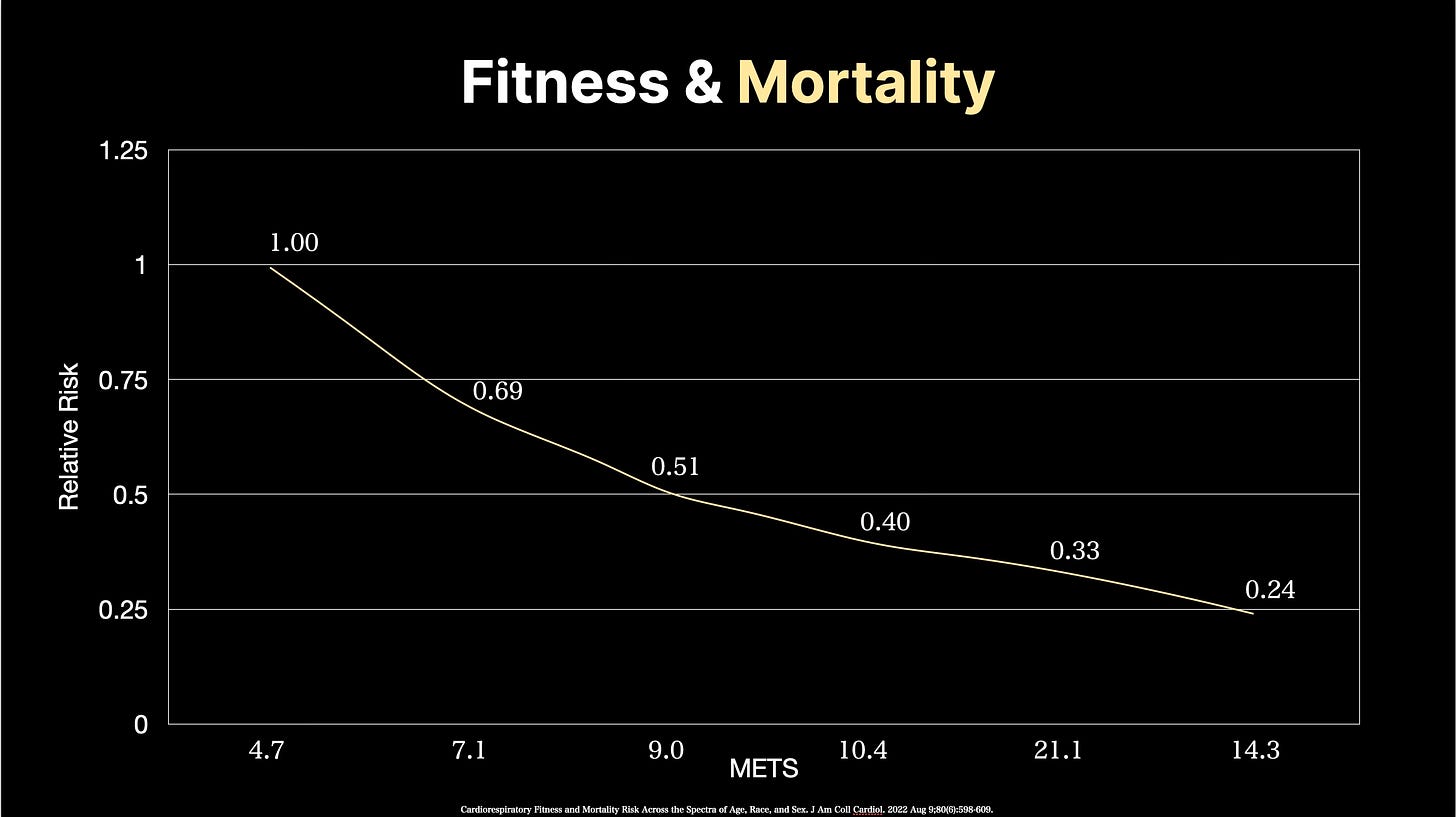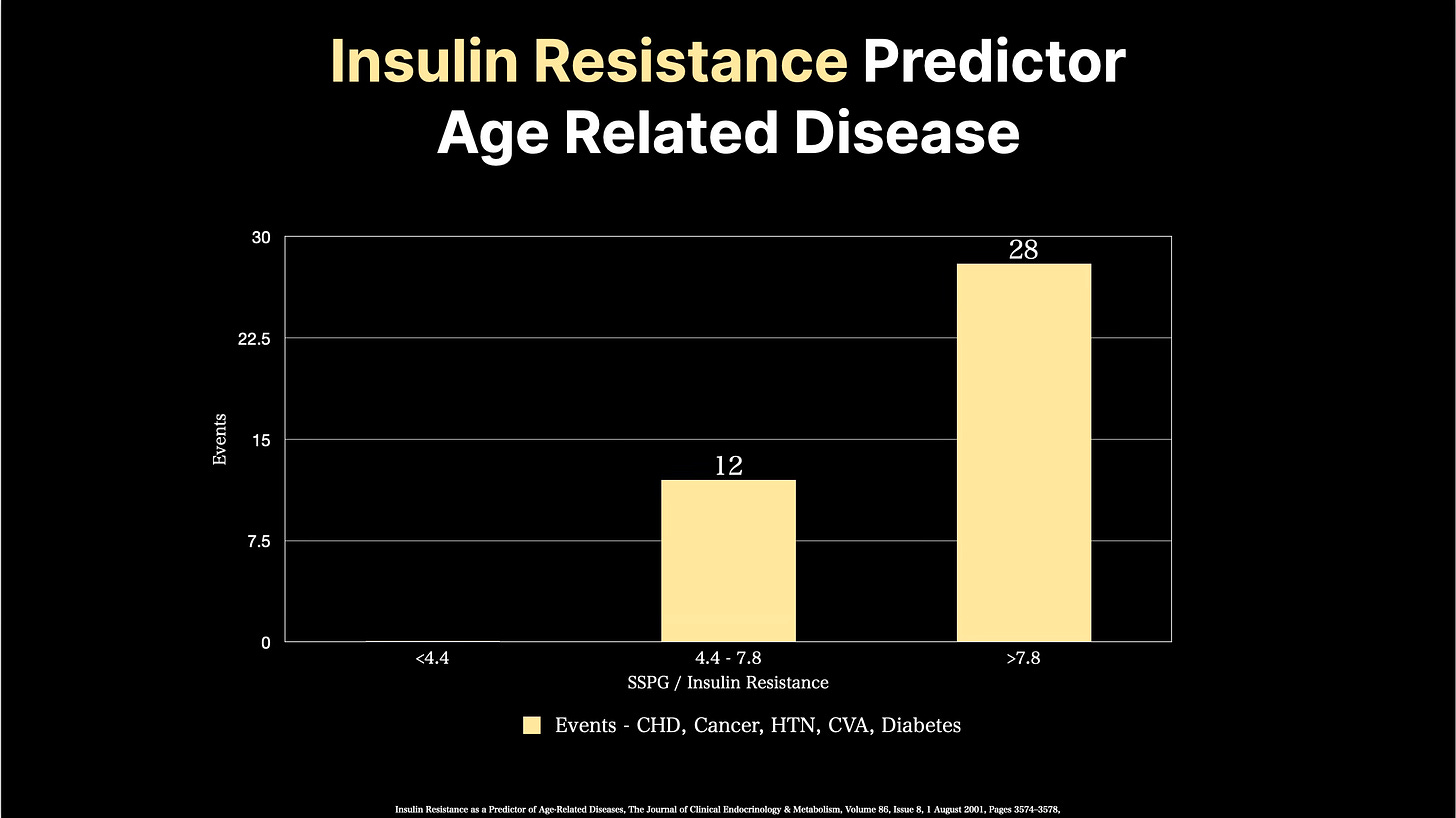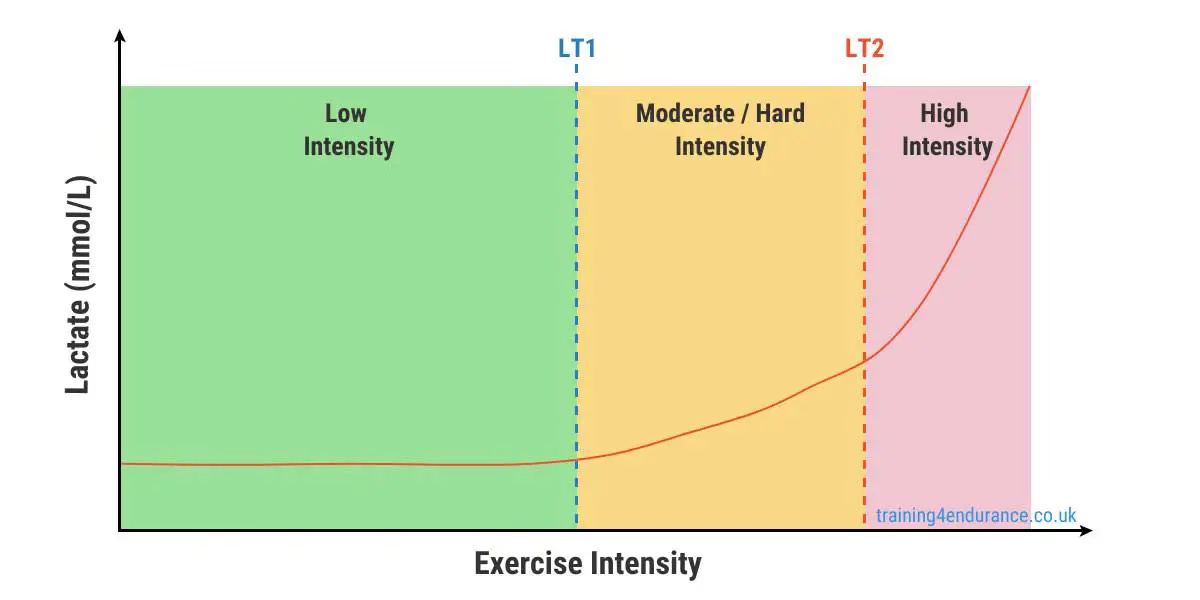How to Define Exercise Zones for Optimal Workout Efficiency. The Essential Guide.

Zone training is one of the few things in life where you can get more for less.
Less effort, more reward.
Who wouldn’t want that?
This is the killer application of zone training.
How you define your zones is one of the most common questions I am asked.
But before we discuss how to define your zones, let’s take a step back to consider why we are doing so in the first place.
My goal is functional longevity.
Not winning the Olympics.
Zone training will help you win the Olympics, but what I am going to talk about here is how a beginner can use zone training to:
-
Get the most out of their exercise routine.
-
With the optimal level of input, which is usually way less than people think.
My goal is twofold.
-
Increase V02 Max.
-
Increase mitochondrial efficiency - the fuel cells of your body.
Why?
High aerobic fitness levels, as measured by V02, are consistently linked to a longer life1.

Improved levels of mitochondria efficiency are linked to lower rates of the major medical conditions likely to cause early death, namely, cardiovascular disease, cancer and dementia2.

So, our goal here is to use the advantages of zone training to optimise both of these factors.
The three steps we need to consider are:
-
Understanding Zones - The fuel used.
-
Defining Zones - How to set your ranges.
-
How much to do - To Achieve our goals.
Understanding Zones - The Fuels Used.
My simple definition of fitness is:
The efficiency at which you turn fuel into energy for your desired use.
In general, you have two fuel sources:
-
Fat - BIG fuel source.
-
Carbohydrate - Small fuel source.
These ingredients generally fuel different muscle fibres, e.g. slow twitch, fast twitch, etc.
But given the size of your fat stores, high fitness levels are typically associated with a high degree of efficiency in turning fat into energy.
You are always using both of these fuel sources but to differing degrees.
Lower Zones = Fat > > > > Carbohydrate.
Higher Zones = Carbohydrate > > > Fat.

There are many different ways to categorise zones, so if you see someone using 5, 6, 7, or 8, they are all just different ways of expressing the same thing.
Our goal is to train our body to use fat for fuel and increase the efficiency of our mitochondria.
To do this, we will need to spend the majority of our time in Zones 1 and 2.
We will also need to spend time in the very top zones, but usually only for small periods of time.
In general, we want to avoid spending time in the middle zones.
Unfortunately, this is where many people spend most of their time.
Lots of time is spent neither optimising for burning fat as fuel nor carbohydrate.
Not a good place to be.
So, how can you tell when you are burning fat or carbohydrate as fuel?
The answer is lactate.
And that is what the next section is about.
Defining Zones - How To Set Your Ranges.
There are two ways to do this.
The accurate and right way or the much less accurate and ‘not the best way’.
Everyone’s zones are different and will change over time.
This is why using a percentage of heart rate is just not ideal.
Formal testing is the best option for any beginner who is serious about getting the most out of exercise to hit their longevity goals.
This can involve one of two tests.
-
A metabolic cart to assess V02 Max and Lactate Thresholds.
-
A lactate threshold test - At a test centre or at home.
Let’s focus on lactate testing, which can be done at home if needed.
Zone 1
As you expend more energy, you will eventually reach a point where burning fat will be inadequate to meet that demand, and you will start to use more carbohydrates for fuel.
At this point, your blood lactate levels will start to rise.

Most people's resting lactate levels will usually be so low that most devices cannot measure it.
As you move, walk faster, or run very slowly, your lactate levels will typically rise.
Generally above 0.3 mmol/L.
Your Zone 1 is this level of effort (e.g. Watts) or a heart rate at this point and 10-15 beats below.
It is a range of about 10 to 15 beats. Not a specific number.
For most people, this will be a VERY EASY effort.
Most people will be very surprised at how quickly they get here.
For very de-conditioned people or those with metabolic dysfunction (e.g. Metabolic Syndrome), they may be above this level even at rest.
Zone 2
This is the range of effort or heart rate between our upper bound of Zone 1 up to a lactate of about 1.8 to 2 mmol/L.
Again, it is a range. Think 10 - 15 beats per minute.
This is where the lactate curve starts to slope upwards.
You are now using more and more carbohydrates for fuel, as evidenced by the increase in lactate levels, which are a byproduct of this process.
These are the two zones you want to spend most of your time in.
What surprises most people is that it is in Zone 1, where heart dilation is at its maximum, and training exposure over long periods in this zone is linked to the biggest increases in V02 Max.
So don’t be afraid to go slow.
Most outdoor runners will learn they might need to walk.
My advice is to get an indoor bike so you can dial in your levels.
And then build from there.
But how do I test my lactate levels?
You can do this at a sports medicine centre or with an exercise coach who will follow a protocol to establish your zones.
For the more enthusiastic of you out there, you can buy a lactate metre and self-test at home. For the more serious athlete, this should be a real consideration.
The testing units are not that expensive. The strips can add up, though.
There are lots of ramp protocols available online.
Zone 5.
This is an all-out effort typically encountered during interval training.
For the beginner, this will primarily be judged on effort and not lactate.
What About The Zones Between 2 & 5.
No man’s land.
In general, these zones are to be avoided if you want to primarily achieve longevity.
Certain sports, however, will need to be selectively trained.
But What If I Don’t Want To Prod My Finger?
You have two options.
-
Talk Test
-
Breath Analysis
Talk Test
Zone 1 & 2 will generally feel easy, and you can comfortably talk.
The problem is when you formally test lactate at these levels, the results can vary wildly, so it's just not very accurate.
But it’s not a terrible place to start.
Long and slow efforts at a very easy pace.
Think of cycling your bike at an easy pace.

Breath Analysis
The Calibre device is a personal wearable that continuously measures expired 02 and C02.
It measures your caloric burn rate and the percentage of calories from fat and carbohydrates.
I have only started using this device myself and haven’t gotten enough time with it to make solid conclusions, but if it lives up to its claim, it could be an incredible tool to assess zones' lives during exercise.

How Much Of Each Zone?
Now that you have a basic understanding of what zones are and how we define them, it is time to talk about dose.
The simple answer is LOTS of Zone 1 and Zone 2.
With a small sprinkle of Zone 5 once a week.
80-90% of your time should be spent in Zone 1 or 2 - ideally in Zone 1.
Remember, Zone 1 = maximum heart dilation.
Don’t believe me?
Eliud Kipchoge, the sub-2-hour marathon runner, does the majority of his training as easy runs.
Now, his easy runs would be similar to most of us on our best days, but his zones are just way different from the rest of us.
But if it’s good enough for him, then it’s good enough for the rest of us.
For most people, 150 to 300 minutes of Zone 1 and Zone 2 per week is a good starting point.
Remember, Zone 1 is super easy, so it’s not that hard to clock up the time.
What most people should avoid is spending 90% of their time in Zones 3 and 4 during every exercise session, which happens far more than you would think.
So, if you want to get more for less when it comes to exercise, zone training might be the answer.
Cardiorespiratory Fitness and Mortality Risk Across the Spectra of Age, Race, and Sex. J Am Coll Cardiol. 2022 Aug 9;80(6):598-609.
Insulin Resistance as a Predictor of Age-Related Diseases, The Journal of Clinical Endocrinology & Metabolism, Volume 86, Issue 8, 1 August 2001, Pages 3574–3578,



